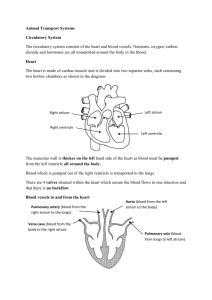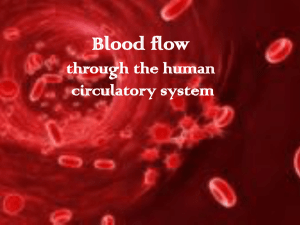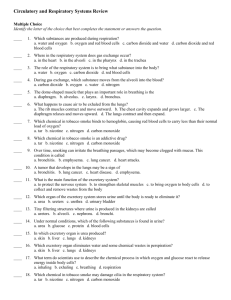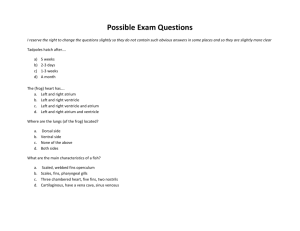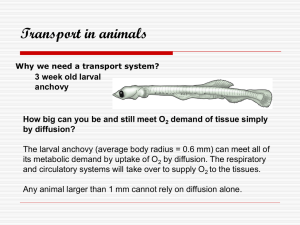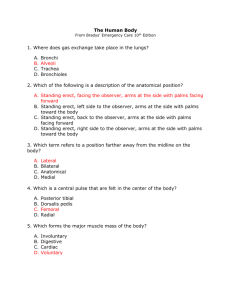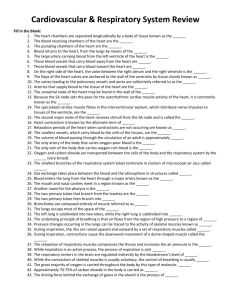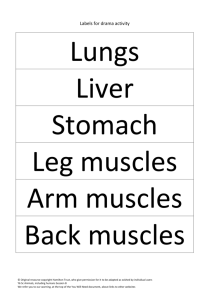3 - Suffolk County Community College
advertisement
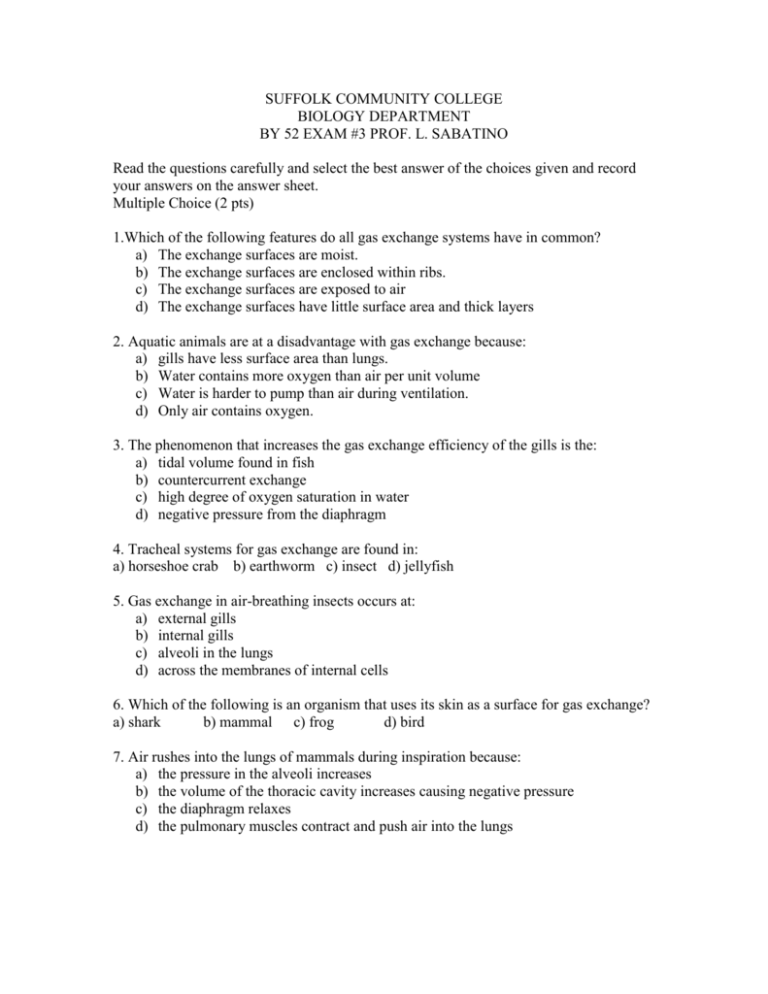
SUFFOLK COMMUNITY COLLEGE BIOLOGY DEPARTMENT BY 52 EXAM #3 PROF. L. SABATINO Read the questions carefully and select the best answer of the choices given and record your answers on the answer sheet. Multiple Choice (2 pts) 1.Which of the following features do all gas exchange systems have in common? a) The exchange surfaces are moist. b) The exchange surfaces are enclosed within ribs. c) The exchange surfaces are exposed to air d) The exchange surfaces have little surface area and thick layers 2. Aquatic animals are at a disadvantage with gas exchange because: a) gills have less surface area than lungs. b) Water contains more oxygen than air per unit volume c) Water is harder to pump than air during ventilation. d) Only air contains oxygen. 3. The phenomenon that increases the gas exchange efficiency of the gills is the: a) tidal volume found in fish b) countercurrent exchange c) high degree of oxygen saturation in water d) negative pressure from the diaphragm 4. Tracheal systems for gas exchange are found in: a) horseshoe crab b) earthworm c) insect d) jellyfish 5. Gas exchange in air-breathing insects occurs at: a) external gills b) internal gills c) alveoli in the lungs d) across the membranes of internal cells 6. Which of the following is an organism that uses its skin as a surface for gas exchange? a) shark b) mammal c) frog d) bird 7. Air rushes into the lungs of mammals during inspiration because: a) the pressure in the alveoli increases b) the volume of the thoracic cavity increases causing negative pressure c) the diaphragm relaxes d) the pulmonary muscles contract and push air into the lungs 8. Which of the following occurs during exhalation of air from the human lungs? a) residual volume leaves the lungs and the alveoli collapse b) the diaphragm contracts and the epiglottis closes c) the volume of the thoracic cavity decreases d) the rib cage expands 9. The mammalian respiratory tract consisting of: a) mucus and cilia to filter the air b) cells that remove water from the air c) a counter current mechanism to extract oxygen d) a trachea connecting directly to the alveoli 10. Air flows in only one direction through the lungs of which animals? a) frogs b) birds c) mammals d) insects 11. Human respiration rate is usually regulated by: a) chemoreceptors that are sensitive to CO2 and pH concentrations in the body fluid b) receptors sensitive to uric acid c) contraction of muscles in the pharynx and mouth d) the SA node 12. Which of the following are characteristics of both hemoglobin and hemocyanin? a) found within blood cells b) red in color c) transport oxygen d) contains the element iron 13. Air in the alveoli has ________ the blood in the pulmonary capillaries. a) more oxygen and less carbon dioxide than b) less oxygen and more carbon dioxide than c) the same levels of oxygen and carbon dioxide as 14. Blood flows from the right atrium to the right ventricle through the: a) semilunar valve c) left atrium b) pulmonary capillaries d) atrioventricular valve 15. Blood pumped from the right ventricle passes through the capillaries of the ______ before entering the left atrium. a) forelimbs b) head c) lungs d) gills e) liver 16. The heart found in frogs consists of: a) one atrium; two ventricle b) two atria; one ventricle c) three atria; no ventricles d) two atria; two ventricles 17. Which of the following has blood flowing directly from respiratory organs to body tissues without first returning to the heart? a) amphibians b) birds c) fish d) mammals 18. The pacemaker of the heart is the: a) nephron b) AV valve c) SA node d) Node of Ranvier 19. The blood vessel with the thickest smooth muscle layer (tunica media) is the: a) artery b) vein c) capillary d) vessel carrying oxygenated blood 20. Which of the following is not true concerning the returned of blood to the heart from the legs? a) Blood moves against the pull of gravity b) The milking action of skeletal muscles surrounding veins causes them to collapse c) One way valves in the veins aid in the return of blood d) The capillaries pump blood into the veins 21. In a closed circulatory system, which of the following is in the correct order for blood flow from the heart? a) ventricle, vein, capillary, artery, atrium b) atrium, vein, capillary, artery, ventricle c) ventricle, artery, capillary, vein, atrium d) atrium, artery, capillary, vein, ventricle 22. An organism in which a circulating body fluid is distinct from the fluid that directly surrounds the body’s cells has: a) an open circulatory system b) a closed circulatory system c) a gastrovascular cavity d) hemolymph 23. Hemoglobin: a) is carried by white blood cells to help fight infection b) is the primary way oxygen in carried in the blood c) is found in insects d) all of the above 24. If the diameter of the arteriole decreases, the flow of blood into the capillary will: a) increase b) decrease c) remain the same 25. Which of the following is an example of osmosis? a) water moving into a cell from a hypertonic environment b) water moving out of a cell into a hypertonic environment c) water being pumped out of a cell into a hypotonic environment d) solute pumped from a hypotonic environment into the cell 26. A plant cell with aquaporins : a) will not become turgid when surrounded by pure water b) will have a faster rate of osmosis than a cell without aquaporins c) is impermeable to water d) can not survive in a terrestrial environment 27. Which of the following statement about xylem is not correct? a) xylem conducts material upward. b) Xylem conduction occurs within dead cells c) Xylem transports sugars and amino acids d) Xylem transports water and minerals 28. Root hairs are most important to a plant because they: a) Are the primary site of photosynthesis b) store starches c) increase the surface area for absorption d) absorb most of the carbon dioxide needed by the plant 29. In plant roots, the Casparian strip is: a) Permeable to water b) Ensures that all water and dissolved minerals pass through a cell membrane c) Increases the surface area for the absorption of minerals d) All of the above 30. Most of the water absorbed by the roots leaves the plant by: a) active transport of ions b) the force of root pressure c) evaporation of water through stoma d) movement into the phloem 31. Cohesion of water molecules is due to the interaction between the: a) hydrogen bonds between water and cellulose of a vessel wall b) covalent bonds between the adjacent water molecules c) hydrogen bonds between opposite polar ends of adjacent water molecules d) covalent bonds between water and cellulose 32. The opening of stomata occurs: a) when guard cells have a decrease in turgor pressure b) when guard cells have an increase in K+ (osmotic) concentration c) when guard cells have a decrease in solute concentration d) independently of guard cells 33. In which of the following would transpiration occur most rapidly? a) a humid night b) a dry, warm day c) a very hot and humid day 34. Phloem transports ____________from the ________ to the _________. a) sugars; leaf; root b) water; root; leaf c) proteins; root; leaf d) sugars; stem; leaf 35. Organisms classified, as osmoconformers are most likely: a) terrestrial b) marine c) amphibious d) found in freshwater lakes 36. Which of the following is a nitrogenous waste that requires hardly any water for its excretion? a) urea b) ammonia c) uric acid d) nitric acid 37. In comparison to ammonia, urea: a) is less toxic b) is more toxic c) requires more water for excretion d) is smaller 38. The main nitrogenous waste excreted by birds is: a) ammonia b) nitrite c) urea d) uric acid 39.. All of the following are functions of the mammalian kidney except: a) water reabsorption c) production of filtrate b) excretion of nitrogenous waste d) production of urea e) osmoregulation 40. Protonephridia are excretory structures found in: a) insects b) vertebrates c) flatworms d) earthworms 41. The name of the process by which material is removed from the filtrate and returned to the blood is: a) filtration b) reabsorption c) secretion d) active transport 42 The majority of the reabsorption occurs in the: a) distal tubules b) Bowman’s capsule c) proximal tubules d) loop of Henle Essay: (4 pts) 1 Define homeostasis. And describe one example of how an animal maintains homeostasis. Be sure to identify the change and the role of the specific cell/organ system used in homeostasis. (12 Pts) 2. Trace the evolutionary changes in animal gas exchange and transport by describing one specific change in gas exchange and transport for each of the following: two germ layer aquatic animals (Hydra) and complex aquatic animals (fish); aquatic animals (fish) and amphibians (frog): amphibians and terrestrial animals (mammals)



